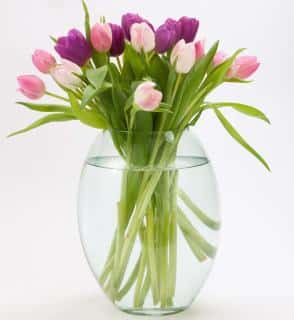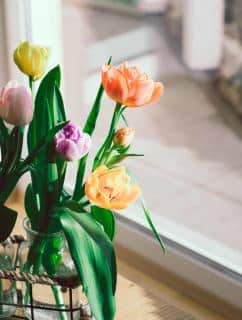

Tulip is the ideal cut flower. What care do cut tulips need? Stems are cut when the flower is still but a bud, and are quickly set in a vase in a bright spot without direct sun. Here is how to care for make tulip bouquets last longer.
In spring, tulips burst forth from deep under our flower beds, illuminating our gardens with bright blooms. Florists showcase them for weeks on end on their market stalls, how do they stay so fresh?
Tulips come in an amazing diversity of species, each more beautiful than the next. However, for cut flower bouquets, lily-flowered tulips are definitely what we recommend for you. From April to mid-May, these varieties bloom with a unique slender, elegant inflorescence, each pointed petal curving back like those of lily flowers. Flowers appear at the tip of long stems that are one and a half to two feet tall (50 to 60 cm). 
For your tulip flower bouquet to keep for more than 10 days, it’s best to pick your tulips while the flower is still a closed bud. A good way to know if it’s ready for picking is to wait until you can correctly detect the color of its first petals.
Whether you’ve picked your tulips yourself or bought them at a florists, always cut the tip off from the bottom of the stems at least half an inch to one inch (1 to 2 cm) before settling them in their vase. Use very sharp scissors and cut the stems slanted. The simple fact of cutting at a slant really helps the tulip absorb water easier. Also, remove the basal leaves, if any, that would otherwise be submerged in water. 
You can stir in the contents of a small pouch of cut flower nutrients, if you were given one. This will definitely extend the lifespan of your tulip bouquet. Nonetheless, mixing in such an additive shouldn’t stop you from replacing the water inside the vase on a regular basis. Change the water every day, even if you don’t have additional nutrients anymore: fresh water is more important. Also, slice a quarter-inch off the stem every day (a few millimeters).
As is the case for most cut flowers, take great care to keep your tulip vase away from direct sun. 
To learn more, read: